
Text © Prof. Paolo Grossoni

English translation by Mario Beltramini
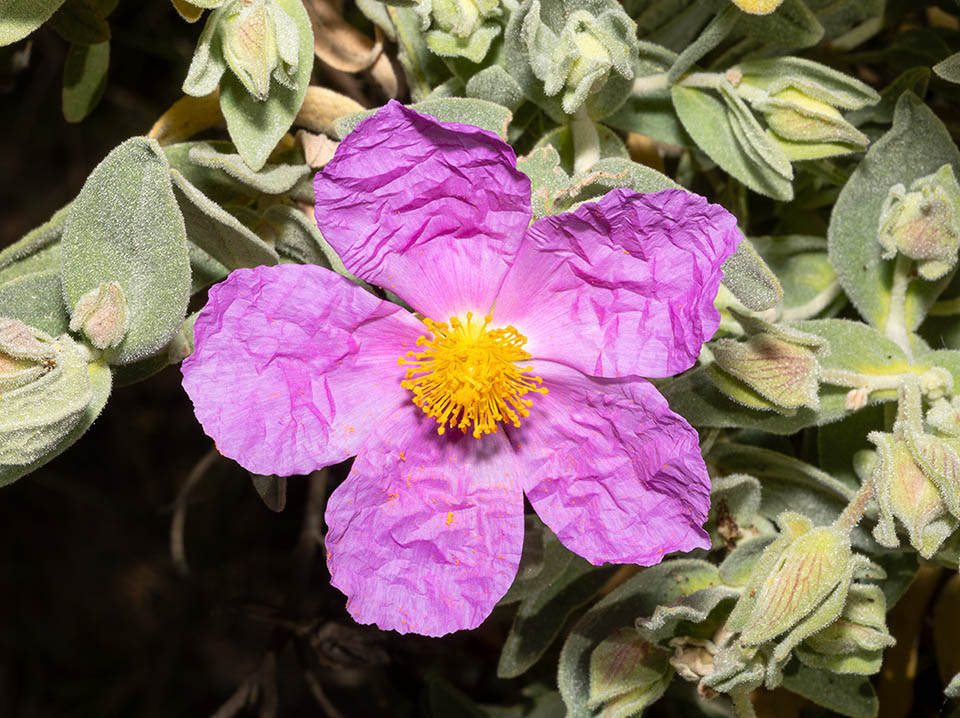
The Cistaceae family, inserted in the Malvales order, gets its name from the genus Cistus. They are often plants typical to the Mediterranean shrub, the garrigues following a fire and uncultivated prairies. In the photo a Cistus albidus with the characteristic crumpled petals. It is a demanding plant requiring calcareous soils © Giuseppe Mazza
According to the classification APG IV (The Angiosperm Phylogeny Group, 2016, Botanical Journal of the Linnean Society, 181(1): 1-20), fourth version of the classification of the Angiosperms based on methodologies of molecular phylogenetics, the Cistaceae belong to the order Malvales Dumort. (1829), order of the Eu-Dicotyledons, or ‘true dicotyledons’ that includes the species whose plants produce ‘tricolpate’ pollen grains, that is with the outer surface marked by three longitudinal apertures (‘colpi’).
Through molecular analyses has been later on confirmed also on genetic bases the constancy of the presence of this character in the plants of most families traditionally included in the Dicotyledons.
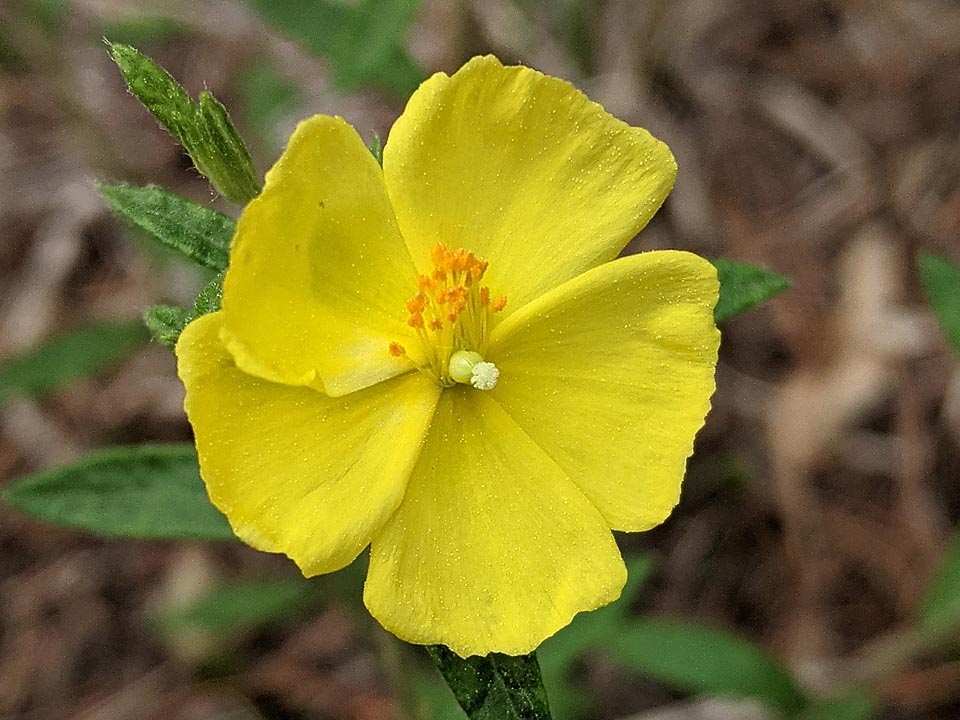
Even if Mediterranean is the family cradle, among the Cistaceae are not absent American species like this Crocanthemum canadense, a perennial grass that, like others of the family, upon the arrival of a pollinator curves on a side the stamens in order to better load it of pollen, uncovering in addition the stigma for other pollinators © Robert Wernerehl
The Malvales are mainly characterized by perfect flowers (bisexual, hypogynous, diclamidate, that is with petals and sepals); the corolla is dialypetalous, the ovary is usually pluricarpellate and, depending on the species, each carpel contains 1 to many ovules. The fruit differs between families and is, also it, an important morphological character.
Various Authors have hypothesized that the first Cistaceae have differentiated themselves in the Tertiary around the end of the Eocene, about 40 Ma, however the first phylogenetic confirmations reach the Miocene around the 18-10 Ma (Guzman and Vargas, 2009, Historical biogeography and character evolution of Cistaceae (Malvales) based on analysis of plastid rbcL and trnL-trnF sequences, Organism Diversity & Evolution, 9(2): 83-99).
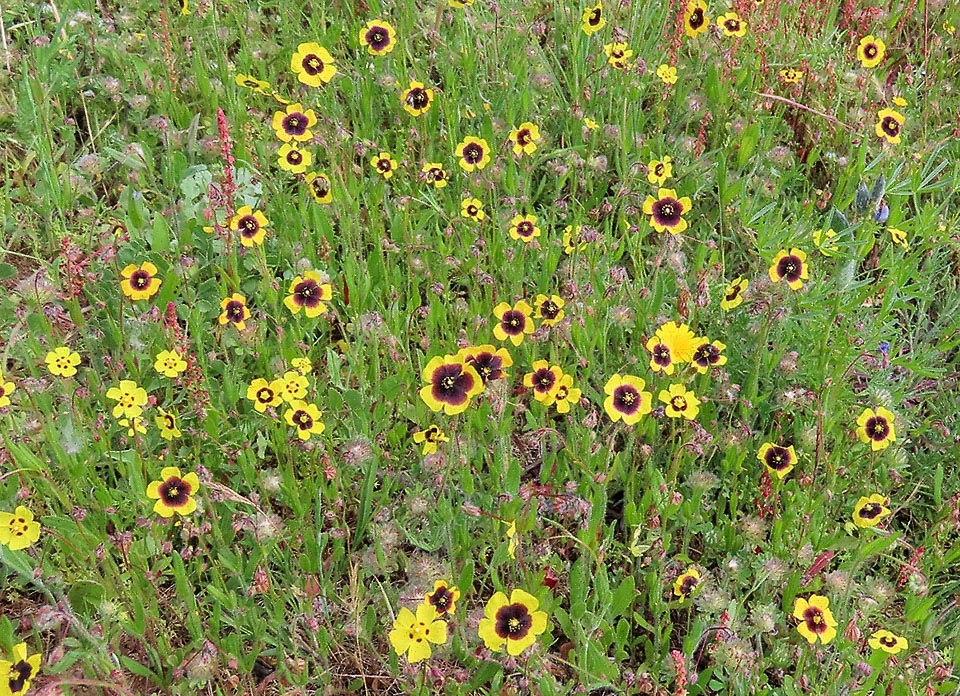
Tuberaria guttata stands out in Mediterranean meadows for the size and colour of flowers. Herbaceous and annual plant, grows on sandy and acidic soils inside the vine area © danzidro
Since all current clades of the family are present in the Mediterranean Basin also with numerous genera and species, it is to be thought that this geographical region has been the area of differentiation of the Cistaceae, then migrated also in the American continent.
But in any case, the changes occurred at the end of the Messinian (5,3 Ma) with the fast return of the waters in the Mediterranean Sea and the establishment of the Mediterranean climate have created, especially along the coastal belt, environments particularly suitable for these taxa that consequently have been able to differentiate, often arriving at characterizing and conditioning the new vegetal formations.
Hence, more than a geographical isolation, have been the ecological conditions to favour the development of the Cistaceae.
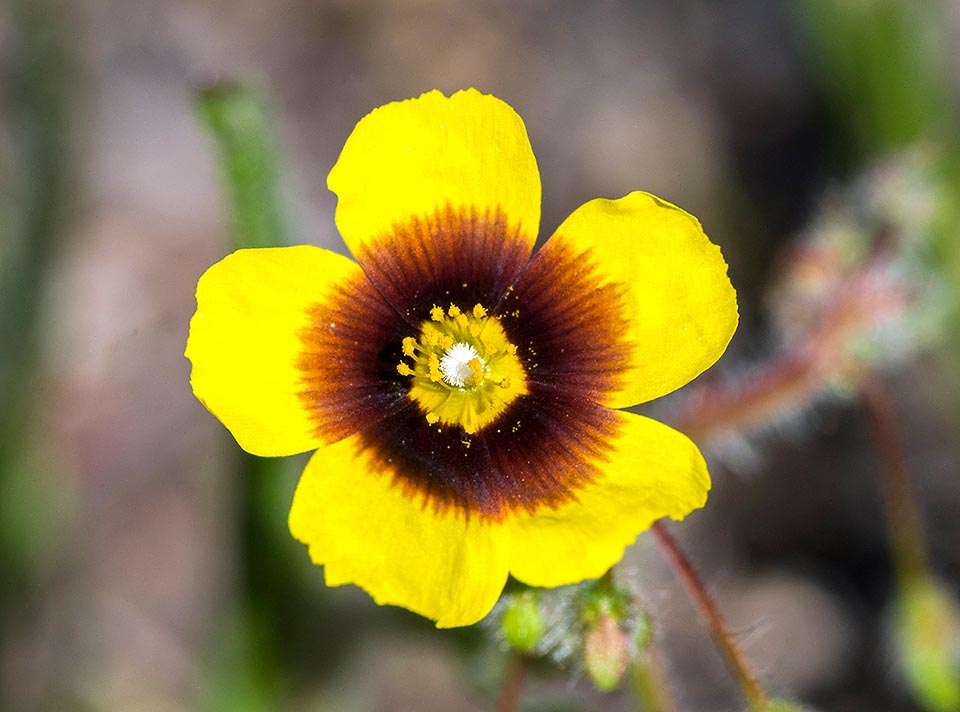
Its splendid flower has yellow petals with a characteristic dark red spot, fringed on the outer edge, covering the claw of the petal but may also be missing © José María Paraíso Hernández
To the family of the Cistaceae Juss. (1789) belong plants characteristic of tropical environments as well as of temperate also cool like those of the mountain or continental ones provided luminous and more or less arid.
They are mainly shrubby species (nanophanerophyte) and low-shrubby (chamephyte), but are not missing annual and perennial herbaceous plants. After the WFO World Flora Online (2024) presently they include 220 species grouped in 8 genera and, with respect to the previous taxonomic order of this family (cfr. ‘The Plant List 2013’), have been cancelled the genera Halimium (Dunal) Spach and Horanthes (Raf.) and has been transferred there the genus Pakaraimaea Maguire & P.S.Ashton.
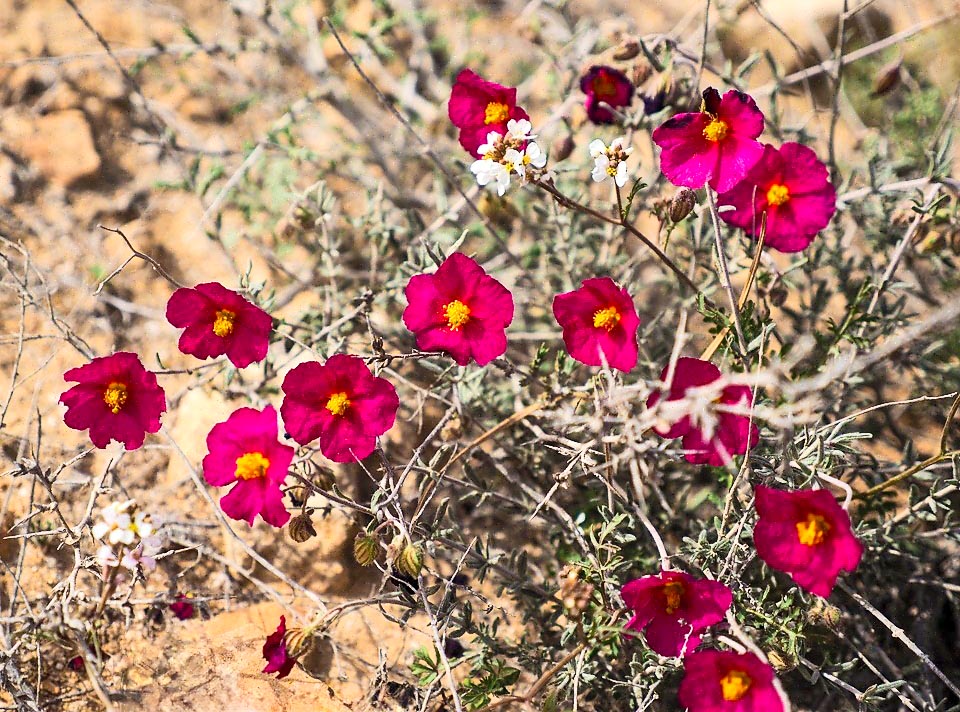
Helianthemum vesicarium is a perennial of south west Mediterranean, from Tunisia to Syria, with lignified stem and pink or dark reddish violet flowers © Yael Orgad
The genera are:
Cistus L. – 34 species, nanophanerophytes plants (NP). The range includes the Mediterranean Basin, from Macaronesia (Canary Islands) and from the Iberian Peninsula to Greece; it then continues from the Anatolian Peninsula to Western Asia up to north-western Iran and all Northern Africa excluding Egypt. Several species are used ornamentally.
Crocanthemum Spach – 20 species, suffruticose chamaephytic plants (Ch suffr.) and nanophanerophytes (NP). The range includes a good part of North America, almost all Central America and, strongly disjointed, South America, from southern Brazil, to northern Argentina. Of little applied interest.
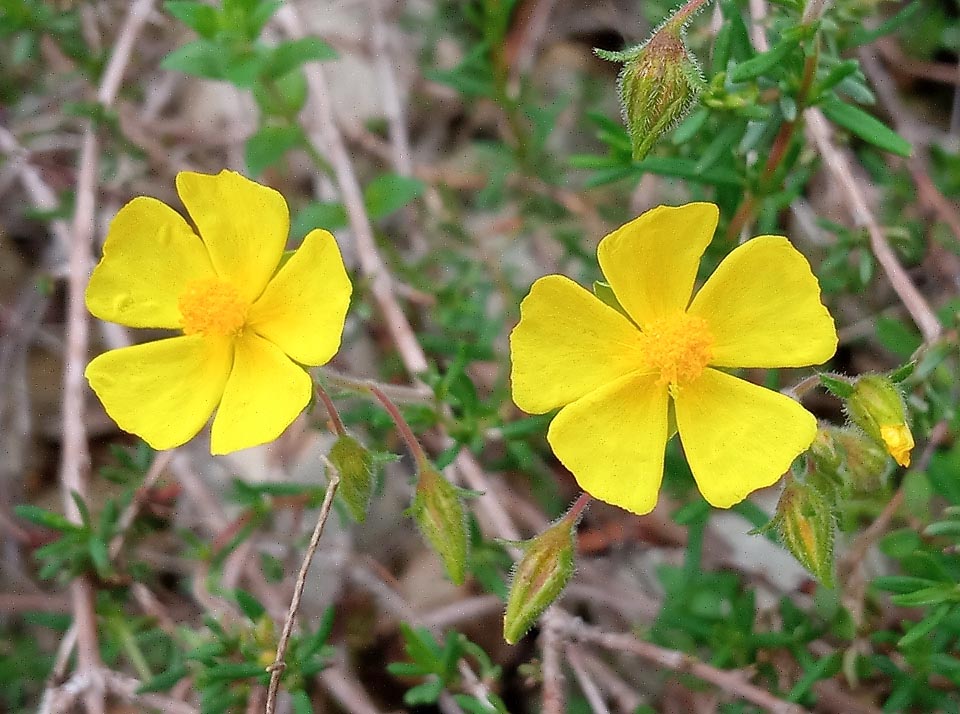
Fumana arabica grows on the Mediterranean shrub limestone soils, in dry garrigues and pastures of Italy , of Balkan peninsula, Western Asia and North Africa © Ali Ali
Fumana (Dunal) Spach – 19 species, all nanophanerophytes plants (NP).The range extends from Scandinavia to southern Europe and continues in western Asia and in North Africa. Of poor applied interest.
Helianthemum Mill. – 112 species, herbaceous plants, therophytes and especially hemicryptophytes (H), and suffruticose chamaephytes (Ch suffr.). It is the genus having the largest range of the family and includes Europe and the Canary Islands, North Africa, Western Asia, Central-Northern China and Inner Mongolia; it is also present in Central America. Several species are employed ornamentally.
Hudsonia L. – 3 species, suffruticose camaephytic plants (Ch suffr.) diffused in North America up to the Canadian Northwest Territories. Of poor applied interest.
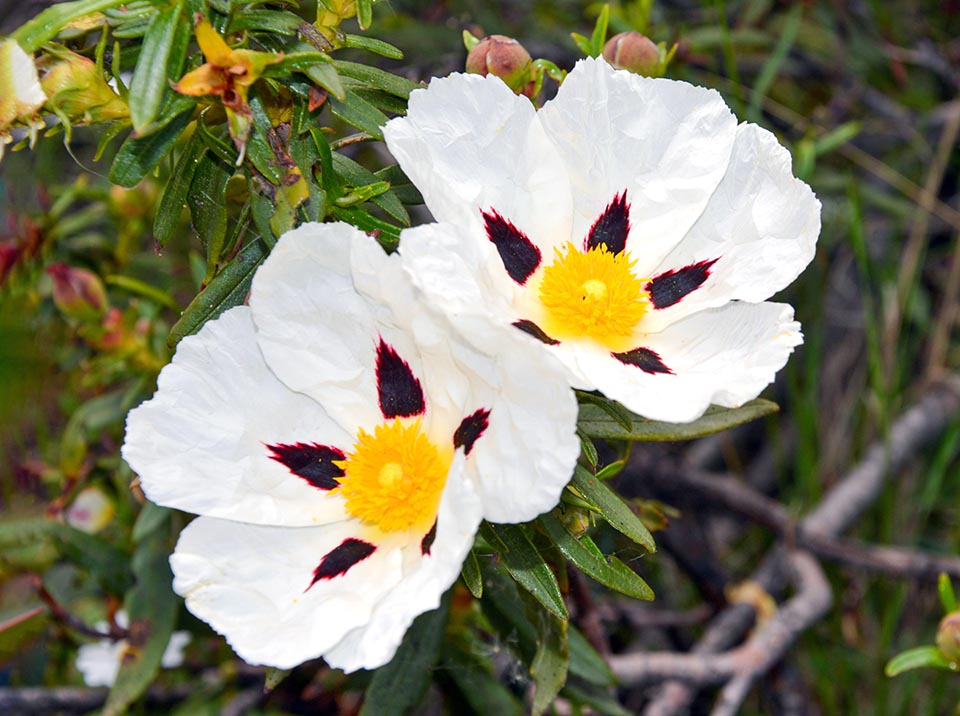
Cistus ladanifer, present in Morocco, Algeria, Canaries and Iberian peninsula, has the largest flowers in the family and is the one offering more nectar to pollinators © Pablo Bernal
Lechea Kalm – 18 species, herbaceous hemicryptophytes plants (H) and suffruticose chamaephytes (Ch suffr.); then grow spontaneously in North and Central America. Of poor applied interest.
Pakaraimaea Maguire & P.S.Ashton, – 1 species, tree plant (P scap). Pakaraimaea dipterocarpacea Maguire & P.S.Ashton is a tree endemism of Guyana and Venezuela that previously was inserted in the subfamily Pakaraimoideae of the Dipterocarpaceae. Of poor applied interest.
Tuberaria (Dunal) Spach – 13 species, herbaceous plants mainly hemicryptophytes (H), but also some annual therophytes (T). They are native to western and Mediterranean Europe, to North Africa (but Egypt) and the Mediterranean regions of Western Asia. Some are employed as ornamental plants.
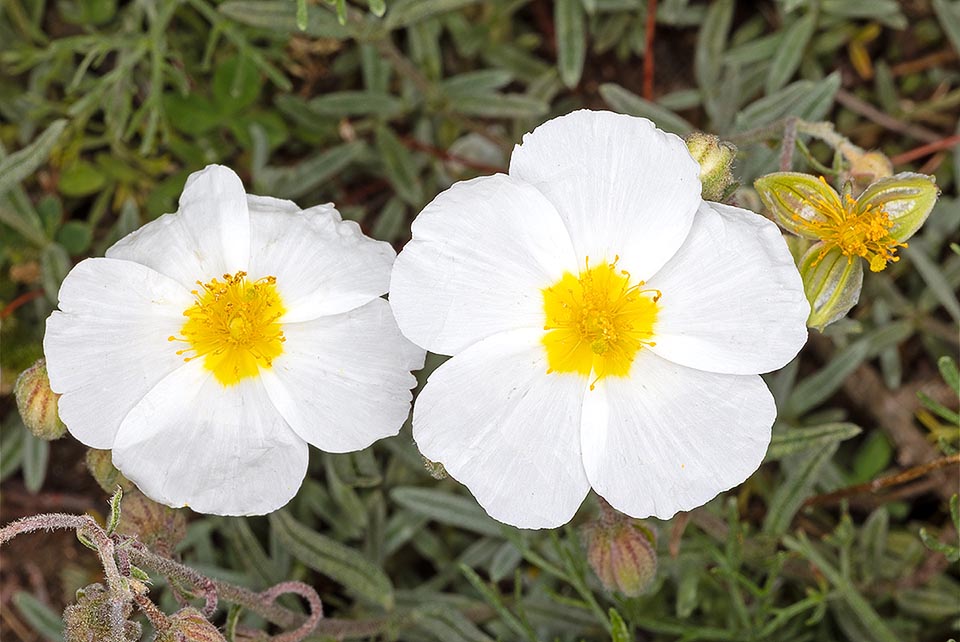
The Cistaceae are diffused also in environments extreme per latitude or longitude. For instance, there are various rock roses colonizing the mountains of all the range of the genus, extending in the Old World and in Central America, growing in the alpine belt or in the snow one. Helianthemum apenninum shown in the photo is common on the western Europe mountains and on Greek ones up to the altitude of 1800 m. To the right of the pair of flowers we can see the 3 valves of a now open fruit © Giuseppe Mazza
The range of the family Cistaceae is therefore centered on two main diffusion centres: the first, adn the oldest, is formed by Europe, the Canary Islands archipelago and the regions of northern Africa and of central and western Asia; the second is the American one predominantly northern, but interesting also some regions of Central and South America.
The genera of the Cistaceae are considered as ‘critical’ because it is not always clearly identifiable the attribution to a certain genus or to a subgeneric taxon. Especially in the genera where more species coexist in the same territories (sympatric species), these uncertainties come especially from the relative hybridization capacity not only among species of the same genus, but also of different genera or with hybrid form due to previous crosses.
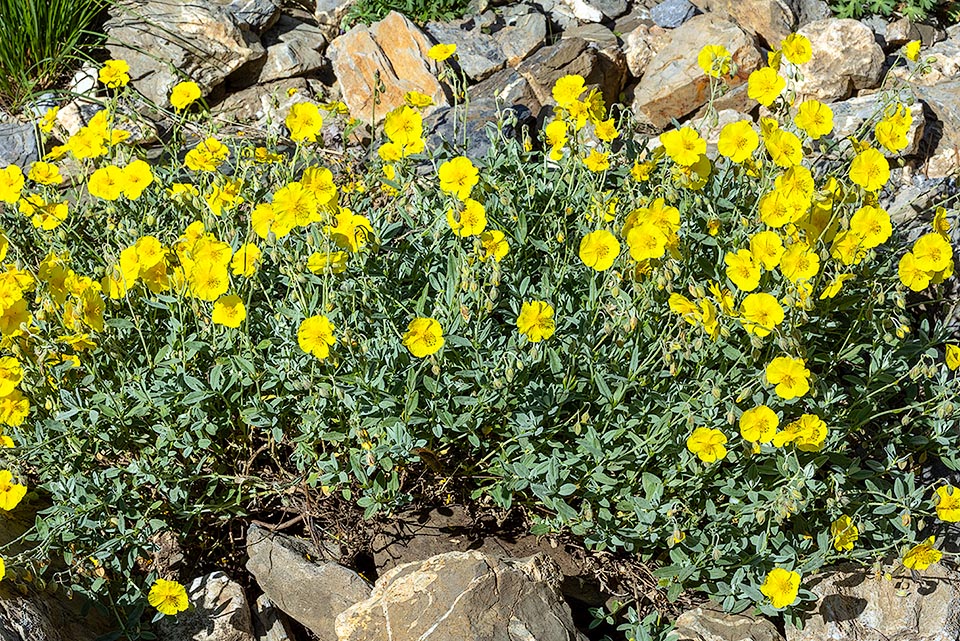
Helianthemum apenninum subsp. apenninum has 5 white petals whilst the subspecies cantrabicum, endemic to the Cantrabian Range has yellow or orange petals © Giuseppe Mazza
The recent molecular-based phylogenetic researches, improving the knowledge concerning the relationships in species and within species, allow to update and review the taxonomical and hierarchical position of the taxa and the intergeneric relations. It is for these reasons that the genera Halimium and Horanthes have been invalidated and their species have been attributed to other genera of the Cistaceae. These revisions have also originated in the genera of the family variations and even notable fluctuations in the number of the species.
The Cistaceae, whether herbaceous or woody, have cylindrical or tetragonal stems that, in many species,are more or less pubescent due to the presence of protecting and/or glandular hairs. The leaves are simple, evergreen (with the obvious exception of the annual species), pedunculate or sessile, stipulate (Tuberaria) or not, pubescent in various taxa.
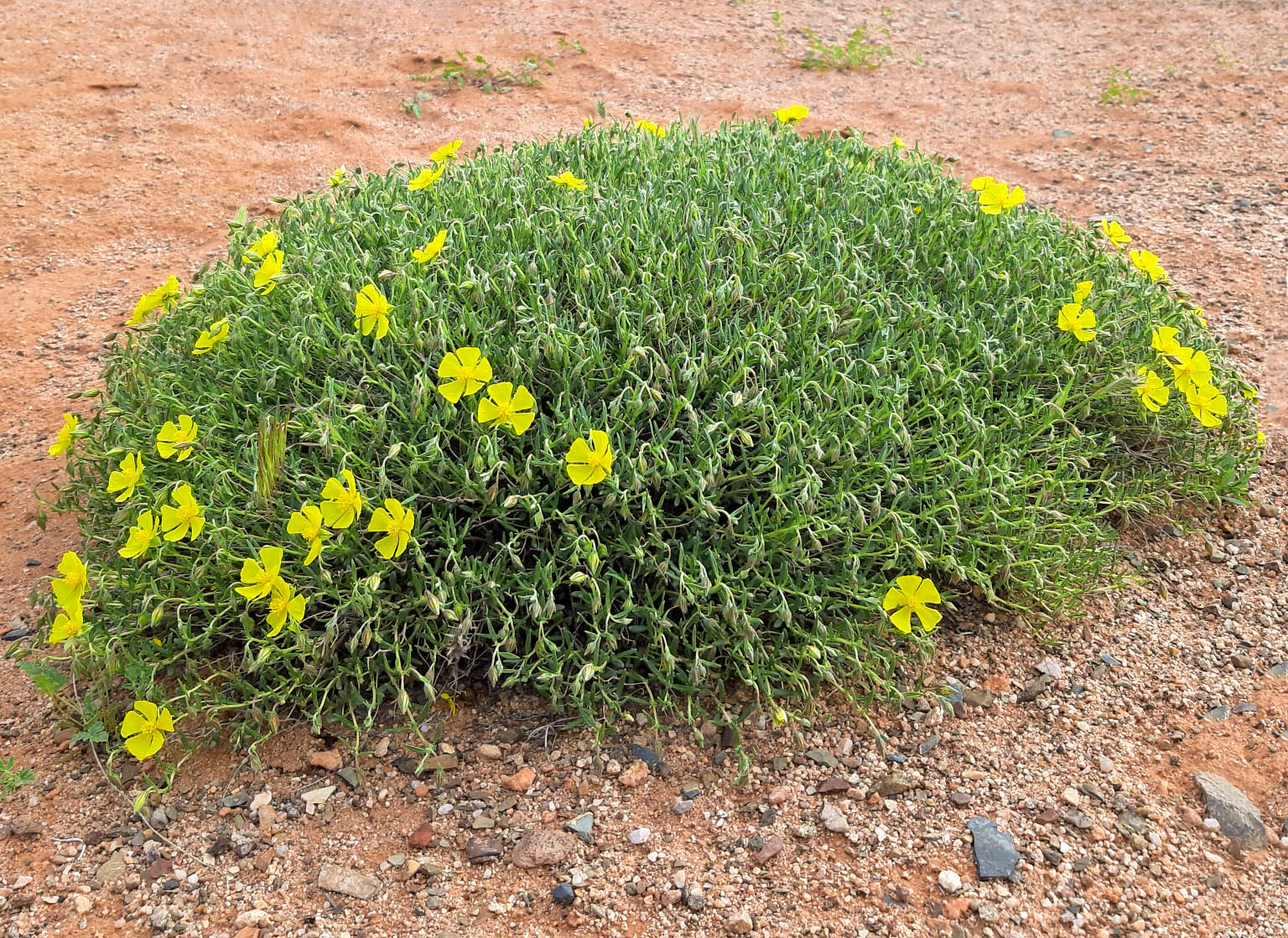
In the East, Helianthemum songaricum has a vast range going from Kazakhstan to all central Asia and reaches, through the Xinjiang, north China © svetlanasp
Cistus, Fumana (partly), Helianthemum and Tuberaria (partly) have opposite leaves whilst Crocanthemum, Fumana (partly), Hudsonia, Lechea, Pakaraimaea and Tuberaria (partly) have alternate leaves; in various herbaceous species the basal leaves are arranged in whorls. The lamina is single-nerved or parallel-nerved due to the presence of 1 or 3 (5) that start from the insertion of the lamina itself that is never lobed and has entire margins often revolute or wavy (rarely crenate or serrate). In the American genera Lechea and Hudsonia some species have scale-like or ericoid leaves.
The flowers, hermaphroditic, actinomorphic and hypogynous, are solitary or merged to form an inflorescence that, depending on the species, can be defined (cymose), with sympodial growth, indefinite (racemose), with monopodial growth.
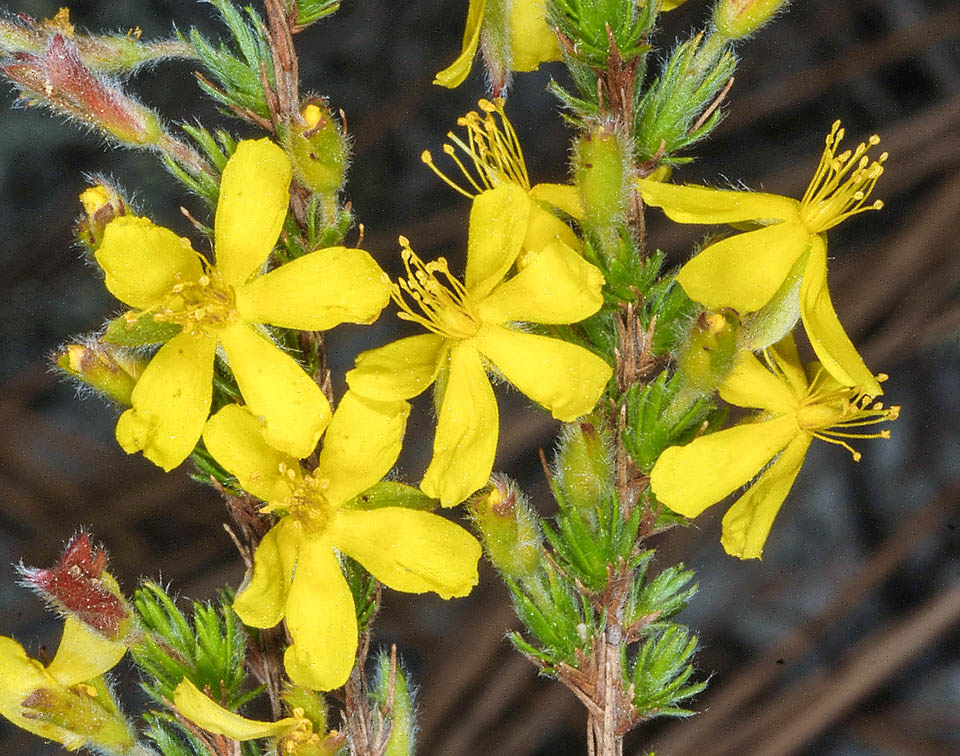
And West, Hudsonia ericoides grows in America from Labrador to South Carolina usually in the sparse or degraded pine forests along the coasts © Douglas Goldman
The flowers, sessile or pedunculated, also showy but usually ephemeral, have the corolla formed by 5 petals, rarely 3 (Lechea and Tuberaria), of white, yellow or red colour but in some instances also brown, pink, fuchsia, orange; at tilmes, even on the same inflorescence, in Crocanthemum, Fumana, Helianthemum, Lechea the normally chasmogamous flowers may be accompanied by cleistogamous flowers with absent or strongly reduced corolla. The calyx is formed by 3-5 more or less persistent sepals.
The stamens vary in number among the species (from 3-5 to 100-200); in many cases, when they are stimulated by the insects they curve outwards thus covering the pollinator with pollen but, at the same time, leaving the stigma uncovered. In this way, even if pollinators are absent, the production of seeds is guaranteed. The ovary is superior with (2) 3-5 (12) carpels and 1 stigma (3 in Lechea).
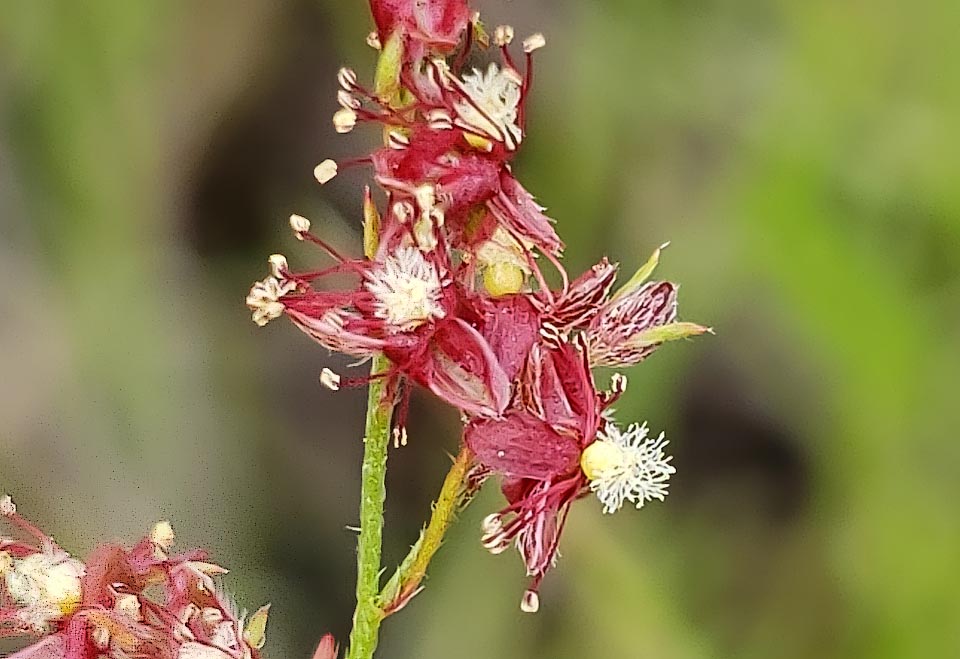
Also Lech tenuifolia is American, quite rare but with very vast range, from Atlantic coasts to the big central plains. It has ephemeral small reddish or brown flowers © Kimberlie Sasan
With the exception of the cleistogamous flowers, the pollination is entomogamous; even if most species do not have nectars, the flowers make up for their lack with a remarkable production of pollen. Some rockroses secrete a small quantity of nectar, but Cistus ladanifer is a glaring exception because it produces it abundantly.
The fruit is a loculicidal capsule, ripening in the year, formed by (2) 3-5 (6-12) valves containing 1 to 2 (Hudsonia) to one thousand (Cistus) seeds per capsule, very small with diameters between 0,5 and 1,5 mm. They are bi-integumented and enclose an embryo equipped with elliptical-orbicular cotyledons strongly curved around the embryo.
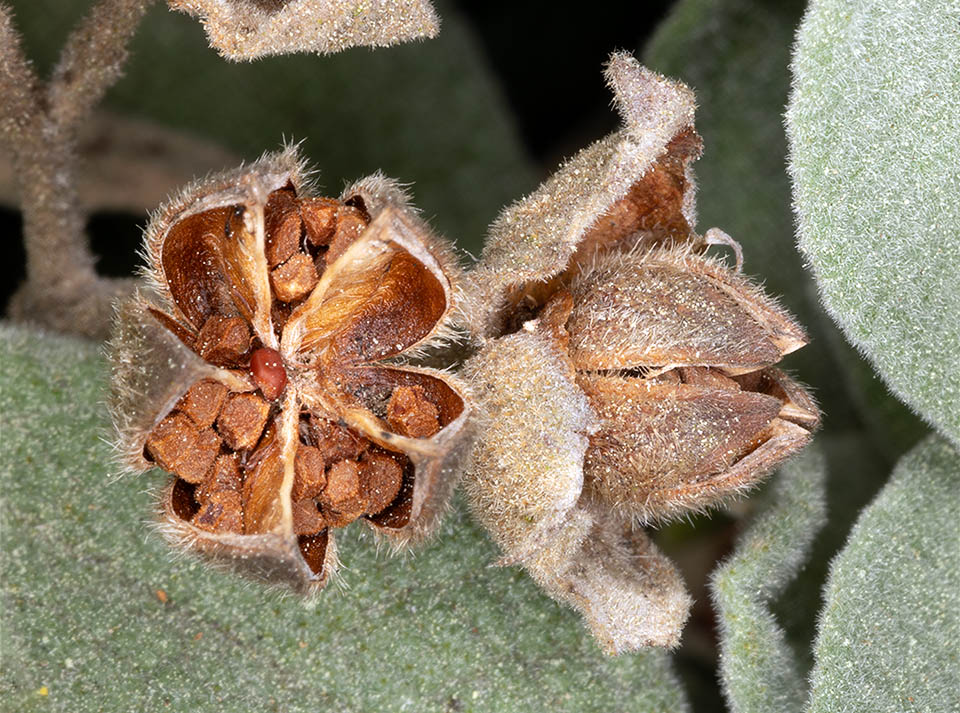
The Cistaceae fruit is a capsule formed by valves ripening during the year. It can contain 1-2 seeds like in the genus Hudsonia or a thousand like in Cistus albidus © Giuseppe Mazza
The integuments and the morphology of the embryo confer the seed a particular resistance to the loss of water and to the strong mechanical pressures; in various tax it permits also to tolerate high temperatures due to the fire (pyrophytism).
Several Cistaceae (Cistus, Fumana, Heliathemum, Pakaraimaea dipterocarpacea) establish ectomycorrhizal associations with various basidiomycetes and ascomycetes (among which fungi of the genus Tuber).
The family counts presently (2024) the following genera: Cistus, Crocanthemum, Fumana, Heliathemum, Hudsonia, Lechea, Pakaraimaea, Tuberaria.
→ To appreciate the biodiversity within CISTACEAE family please click here.
